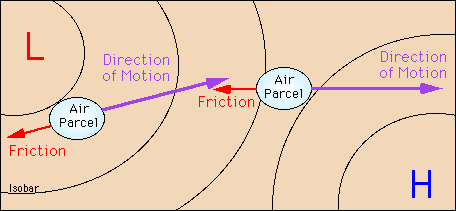

Friction is based on two factors -- the speed of the object in motion, and the the relative viscosity of the fluid through which the object travels. Huh? All that really means is that friction is greater in denser fluids. Therefore, the friction for a block of wood traveling through the air would be less than for the block of wood traveling through water at the same speed. Water is much more dense than air. For our purposes, it means that friction is much greater near the surface (where the air is more dense and more turbulent) than aloft (where air is significantly less dense and less turbulent). Friction is an important force on air near the surface, but is insignificant above about 1 km. Therefore, the layer of air in which friction is important is known as the friction layer. The air above the friction layer is known as the free atmosphere because there is no significant friction. The height of the friction layer varies greatly, but is usually between 1 and 2 km. The friction layer is also known as the planetary boundary layer (PBL). We discuss friction further in the Microscale section of Session 5 and discuss the PBL in Session 7.
Friction, Coriolis, and the PGF are summed together to get the net force placed on a parcel of air. If this net force is zero, there is said to be a balance of forces. If there is a net force greater than zero, then the parcel of air is said to have an acceleration, which we discuss next.
 The Shodor
Education Foundation, Inc.
The Shodor
Education Foundation, Inc.